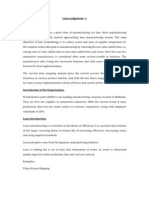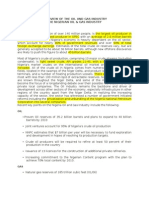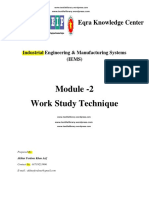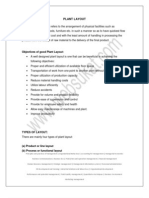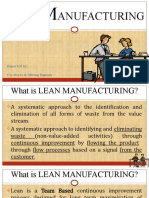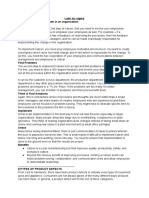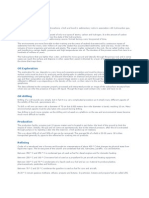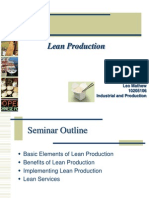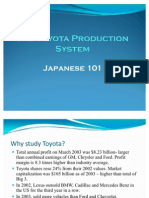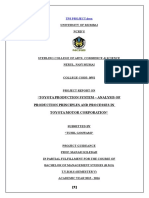100%(1)100% found this document useful (1 vote)
2K viewsLean Management Assignment
Lean Management Assignment
Uploaded by
Elorm Oben-TorkornooSo this is one of my assignments i produced for the Operations Management class at the postgraduate level. Had a grade 'A' and with great comments from my lecturers...Wish to share with the rest of the student world
The paper looks at the impact of lean tools on a rather simple production process for one of the product lines in a company called InkIt. Originally, i used NORVI Stationery, a company i had worked for for the past 7 years, but the company has not got any website so i used a competing business.
Value Stream Mapping (VSM) is used to reduce the lead time from 14 days to 2 working days. That is the power of lean production. However, there are challenges to the lean concept as well.
You comments are most welcome.
Copyright:
© All Rights Reserved
Available Formats
Download as DOCX, PDF, TXT or read online from Scribd
Lean Management Assignment
Lean Management Assignment
Uploaded by
Elorm Oben-Torkornoo100%(1)100% found this document useful (1 vote)
2K views14 pagesSo this is one of my assignments i produced for the Operations Management class at the postgraduate level. Had a grade 'A' and with great comments from my lecturers...Wish to share with the rest of the student world
The paper looks at the impact of lean tools on a rather simple production process for one of the product lines in a company called InkIt. Originally, i used NORVI Stationery, a company i had worked for for the past 7 years, but the company has not got any website so i used a competing business.
Value Stream Mapping (VSM) is used to reduce the lead time from 14 days to 2 working days. That is the power of lean production. However, there are challenges to the lean concept as well.
You comments are most welcome.
Copyright
© © All Rights Reserved
Available Formats
DOCX, PDF, TXT or read online from Scribd
Share this document
Did you find this document useful?
Is this content inappropriate?
So this is one of my assignments i produced for the Operations Management class at the postgraduate level. Had a grade 'A' and with great comments from my lecturers...Wish to share with the rest of the student world
The paper looks at the impact of lean tools on a rather simple production process for one of the product lines in a company called InkIt. Originally, i used NORVI Stationery, a company i had worked for for the past 7 years, but the company has not got any website so i used a competing business.
Value Stream Mapping (VSM) is used to reduce the lead time from 14 days to 2 working days. That is the power of lean production. However, there are challenges to the lean concept as well.
You comments are most welcome.
Copyright:
© All Rights Reserved
Available Formats
Download as DOCX, PDF, TXT or read online from Scribd
Download as docx, pdf, or txt
100%(1)100% found this document useful (1 vote)
2K views14 pagesLean Management Assignment
Lean Management Assignment
Uploaded by
Elorm Oben-TorkornooSo this is one of my assignments i produced for the Operations Management class at the postgraduate level. Had a grade 'A' and with great comments from my lecturers...Wish to share with the rest of the student world
The paper looks at the impact of lean tools on a rather simple production process for one of the product lines in a company called InkIt. Originally, i used NORVI Stationery, a company i had worked for for the past 7 years, but the company has not got any website so i used a competing business.
Value Stream Mapping (VSM) is used to reduce the lead time from 14 days to 2 working days. That is the power of lean production. However, there are challenges to the lean concept as well.
You comments are most welcome.
Copyright:
© All Rights Reserved
Available Formats
Download as DOCX, PDF, TXT or read online from Scribd
Download as docx, pdf, or txt
You are on page 1of 14
2014
Daniel Elorm Oben-Torkornoo
Module Title: STRM 023
Module Name: Managing Operations
Date: 24
th
May, 2014
Word Count: 2,724
Lean Management: Theory and Applications to
Production of promotional pennants
2
ABSTRACT
Effective operational performance requires understanding of what value is to the consumer. This
understanding will lead to identification of activities or processes not-valued by the customer and yet
creates cost for the organisation. Lean management, a concept which proposes identifying waste,
adding value and continuously improving the process is a philosophy that has changed how companies,
not only in manufacturing but also services, run their activities.
The phenomenon has been useful in industry in concepts such as total quality management, Kanban,
five S, cellular manufacturing, and total preventive management. Some of these applications are
explained within this report.
Though lean has been widely praised by many researchers and practitioners all over the world, some
have also raised concerns about another phenomenon that has plagued the world now; Sustainability.
The lean philosophy seems to be about implementing long term goals through short term approaches,
thus, the issue of environmental sustainability is of great concern.
3
TABLE OF CONTENT
ABSTRACT .. 2
1.0 INTRODUCTION . 4
2.0 LEAN MANAGEMENT CONCEPTS . 6
2.1. THE CONCEPT OF WASTE 6
2.1.1. Defect .. 6
2.1.2. Over Processing 6
2.1.3. Motion . 6
2.1.4. Waiting 7
2.1.5. Inventory/Back log . 7
2.1.6. Transportation .. 7
2.1.7. Underutilisation/Non-Utilisation of staff 7
2.1.8. Overproduction . 7
3.0. VALUE AND FLOW 7
4.0. APPLICATIONS AND FRAMEWORKS OF LEAN . 8
4.1. CELL MANUFACTURING . 8
4.2. JUST-IN-TIME (JIT) SUPPLY 8
4.3. FIVE Ss .. 8
4.4. KANBAN . 9
5.0. BENEFITS OF LEAN MANAGEMENT . 9
6.0. ARGUMENTS AGAINST THE LEAN PHILOSOPHY . 9
7.0. LOOKING INTO THE FUTURE OF LEAN .. 10
8.0. FUTURE VSM FOR PRODUCTION OF PENNANTS .. 10
9.0 COST-BENEFIT ANALYSIS .. 12
10.0 CONCLUSION . 12
REFERENCES 13
4
1.0 INTRODUCTION
All the steps required to take a product or service from its raw state into the waiting arms of a
customer is defined as value stream (Pereria, 2008). These processes could either be value added or
non-value added
Value Stream Mapping will be done for a popular product line; Promotional Pennants for educational
institutions and corporate institutions. The name of the company for which this Value Stream map is
being drawn is called INKIT Ghana Limited (Inkit Ghana, 2011). The company receives several inquiries
from clients from her clients who wish to produce paraphernalia for their marketing campaigns. It
currently turns down about 60% of request due to overloaded work schedule.
Over the years, the company has used a lead time of, at best, 14 days to deliver a batch of 50 items, on
the average, to each customer.
The entire process from order to delivery is outlined as follows:
1. Activity 1: the customer makes initial contact with the company (through telephone) and
requirements are received and recorded. This is received by the office staff.
2. Activity 2: Office staff communicates the requirements to the graphic designer who translates
these ideas into graphics.
3. Activity 3: Based on the design produced, samples are then made for the client to approve.
Sample wood bars and other materials are purchased from suppliers in smaller proportions.
4. Activity 4: Two samples are produced for the clients approval.
5. Activity 5: The client confirms the sample quality and then gives go ahead for production to be
done. Confirmation of orders is done by the client signing an agreement and making a 50%
deposit for the total cost of production.
6. Activity 6: Orders are given to carpenter to make wooden bars for the pennants. The bulk is
produced based on sample produced.
7. Activity 7: Other materials are purchased for the production of the pennants. Materials include
cloth, foam, and other accessories.
8. Activity 8: Materials/Cloth are then transported to the screen printer
9. Activity 9: Cloth is cut according to approved measurements and printed by the screen printer
10. Activity 10: Printed cloths, foam and wooden bars from carpenter are transported to the
tailors
11. Activity 11: the tailor stitches the cloths with other accessories
12. Activity 12: All items are transported to the office of InkIt Ghana Limited for packaging
13. Activity 13: All items are delivered to the consumer
Figure 1 below summarizes in picture form the entire value stream for the activities listed above and is
a true representation of how things are done now within the organisation.
5
6
2.0 LEAN MANAGEMENT CONCEPTS
Businesses, irrespective of what industry they belong to must focus on delivering value to the
customer in order to succeed in the business environment (Cudney & Elrod, 2011).
Melton( 2005) identified lean as a philosophy built on three main concepts: the identification of
value, the elimination of waste and the general flow (of value to the customer). Cudney & Elrod
(2011) also share the same opinion that it focused on the identification and elimination of waste in
production, product development and service industries.
Lean started in Japan within Toyota and the production system was a ceaseless flow of relatively
shorter production lines which were more efficient (Emiliani, 2006). The Western world, with FORD
Motors as the leaders, was using mass production based around materials resource planning (MRP)
(Melton, 2005). This system used complex computerised system for the production process (Melton,
2005).
2.1 THE CONCEPT OF WASTE
Emiliani (2006) emphasises waste as a perception from the final consumer that an activity does not
add value to the production process. This means that what the organisation thinks is important may
not be the case for the consumer. According to Bhasin & Burcher (2006), there could be up to a 40%
reduction in waste if lean management is implemented. There are 8 kinds of waste (Kavanagh &
Krings, 2011)
2.1.1. Defects: Kavanagh & Krings (2011) believe that a defect occurs when an incomplete or
incorrect item is passed on to the next step in the process or to the final consumer. According to the
authors, avoiding defects begins with understanding the customers definition of service quality.
Defects result in reworking as a result of products being found to be defective and have to be
reworked or disposed of, both a costly process. They are mainly caused by poor or inferior
manufacturing processes as a result of either human error or equipment breakdown or both.
2.1.2. Over processing: Over processing involves executing a task in a manner than results in
the giving the customer or recipient more than what was requested (Kavanagh & Krings, 2011). For
instance, wrapping an item with rubber, placing it in paper wrappings, and then finally putting it into
a box.
2.1.3. Motion: Motion relates to excessive human movement within the workplace (Bhasin
& Burcher, 2006). Poor work area layout can be a major cause of this kind of waste. A process
should produce reliable results the first time it is performed (Kavanagh & Krings, 2011). For this
reason double(or triple) inspection and checking is considered a form of waste because there is a lot
7
of motion. The process should therefore be made effective and efficient enough to eliminate
inspections and checkings completely.
2.1.4. Waiting: Waiting is the idle time created when employees wait for resources like
invoices, copiers, parts, machines, etc. from coworkers (Kavanagh & Krings, 2011). This tanslates
into downtime when people and equipment are not creating value. If operators, equipment,
information or materials delay the production process for any reason, time is wasted and cost of
production will increase further impacting, cumulatively, on profitability.
2.1.5. Inventory/Backlog: According to Kavanagh & Krings (2011), in an administrative
process, the sum of all tasks waiting to be processed is considered inventory or backlog.
Investopedia (2014) defines inventory as the raw materials, work-in-process goods and completely
finished goods that are ready for use or consumption by the consumer. They take up space and
space cost money. There is also the danger that they may become obsolete.
2.1.6. Transportation: Transporting anything that does not add value to the final consumer is
considered waste (Kavanagh & Krings, 2011). According to the authors, this does not only include
the movement of materials and documents, but also the movement of customers from one desk to
another, a practice very common in government institutions.
2.1.7. Underutilisation/Non-utilisation of Staff: This type of waste is the failure to make full
use of the employees skills, knowledge and abilities (Kavanagh & Krings, 2011). When skill and
abilities of staff are not utilised there is waste. Missed improvement opportunities and learning
opportunities by simply not listening to your staff is also a form of waste under this category (Jiju,
2011)
2.1.8.Overproduction: This is the production of more product than what the customer
requires, or making it much earlier than necessary (Walters, 2011). This is the worst waste as it has a
knock-on effect in multiplying all the other wastes. According to Walters, over production increases
defects, impacts on inventory costs, process chains, waiting, unnecessary motion and
transportation.While all these wastes are unlikely to be present within a process simultaneously, it
is important to treat them all equally because the goal of lean is total elimination of waste.
3.0. VALUE and FLOW: These are the other two concepts under lean management which also
require some level attention.
Understanding what value is to the customer and clearly defining your value proposition as an
organisation is key to lean management (Melton, 2005). Beyond the process industries there are
many examples of what we mean by a value propositionas a consumer buying a television set
8
what may be valued is the ability to watch our favourite movies at home; for others the value may
be related to cost or specific design features or even the size. The challenge for the manufacturer is
to develop a product portfolio based on these value propositions. Not meeting the customers value
proposition may lead to all the types of waste mentioned above.
Flow is probably the hardest lean concept to understand. It is the concept which most obviously
contradicts with mass production systems; the comparison of one piece flow versus batch and
queue processes (Melton, 2005). The lack of flow in most manufacturing processes is likely to be
what accounts for the huge warehouses which house the mass of inventory which consumes the
working capital of business; both state-owned and private. Melton (2005) aurgued the importance
of understanding value stream to gaining a proper understanding of flow. The value stream
ultimately delivers value to a customer. According to the author, value stream crosses functional
and, usually, organizational boundaries.
4.0. APPLICATIONS AND FRAMEWORKS OF LEAN
Over the years, Lean has moved away from the philosophy used in manufacturing firms to one used
across all industries and sectors, including office processes (Cudney & Elrod, 2011). Lean
manufacturing has been used in all continents and in various sectors including industry and service
segments (Moori, et al., 2013).
4.1. Cell Manufacturing: Manufacturers have adopted initiatives aimed at reducing
the setup time of equipment, making manufacturing cell manufacturing more flexible and improving
quality. The benefits of cellular manufacturing include: Work-In-Progress reduction, optimisation of
space, reduction in lead time, productivity improvement, quality improvement, enhanced
communication and teamwork, enhanced flexibility and visibility (Dolcemascolo, 2004). While this
system has been widely used, researchers have asked the question of whether there could be more
effective manufacturing layouts.
4.2. Just-In-Time (JIT) Supply: The purpose of JIT is to respond more quickly to push
and pull of organizations supply chain (Mistry, 2005). It is a philosophy which is focused on
improving continuously and eliminating waste in the process. JIT tackles issues such as on-time
delivery, quality, minimal inventories and cost reduction (Gray, 2010 cited in (Pravab, 2012). It also
suggests several intermittent trips to deliver raw materials which raise the question of
environmental sustainability (Martnez-Jurado & Moyano-Fuentes, 2013)
4.3. Five Ss: The simplicity of the five Ss is its main strength (Melton, 2005). This
focuses on effective workplace organisation and standardisation (Abdulmaleka & Rajgopalb, 2007).
Sort refers to organising and eliminating the unnecessary while systemise refers to arranging things
in a way that they are accessed conveniently. Scrub refers to ridding the entire shop floor/workshop
9
of dirt. The machines and the working environment should be clean and tidy. Standardising refers to
maintain a pleasant environment. Standardising the previous four Ss and constantly improving
them is the last S, which is sustain.
4.4. Kanban (Visualisation): In Japanese, the word Kan means "visual" and "ban"
means "card," so Kanban refers to visual cards. Lean uses visual cards as a signalling system that
triggers an action to supply the process with its needs either from an external supplier or from a
warehouse (Sabry, 2014). This is a design solution to materials flow problems within a process
(examples within both manufacturing and lab situations have been seen) (Melton, 2005).
5.0. BENEFITS OF LEAN MANAGEMENT
Research conducted by Moori, et al. (2013) on lean manufacturing and business performance on
manufacturing firms revealed there was a direct relationship between the elements of Lean
Manufacturing Management and Business Performance. The business performance refers to the
operation and financial performance of the organisation.
Researchers have also suggested that the implementation of these practices is associated with
higher operational performance, such as a lead time reduction for customer, shorter manufacturing
cycle time or lower manufacturing costs, and an improvement in labor productivity and quality (De
Treville and Antonakis, 2006; Hopp and Spearman, 2004; Sherrer-Rathje et al., 2009; White et al.,
1999 cited in Hajmohammad, et al., 2013).
6. ARGUMENTS AGAINST THE LEAN PHILOSOPHY
The huge recalls by Japanese automaker Toyota in 2010 questioned the benefits of this
management model/philosophy. Schonberger (2009), by following up financial statements of
manufacturing companies, found that Toyota, despite initiatives to reduce waste in the period from
1990 to 2005, in fact showed a reduction of 3.4% of inventory turnover per year, i.e., an increase
over the years in its inventory levels in comparison to sales.
Proponents of environmental sustainability have also condemned the lean philosophy. The concept
discourages inventory, and in large quantities. This implies that an inventory management system
where they raw materials arrive in bulk to be kept for future orders will have to be replaced with
short trip-deliveries to the warehouse. This subsequently increases the overall carbon footprints of
the
JIT is believed to cause congestion in the supply chain, leading to delays, pollution and shortage of
workers (Cusumano, 1994 cited in Pravab, 2012).
10
Lean has also been criticised by (Hines, et al., 2004) as lacking consideration of human aspects. All
the principles of lean are focused mainly on flow of materials and information as well identification
of value and waste with total disregard to the employees within the organisation.
7.0. LOOKING INTO THE FUTURE OF LEAN
While criticisms are raised by various researchers about the weakness of the philosophy, it is my
expectation to see the theory develop to become a bit person-focused. Processes will not be able to
function without competent people overseeing them. Human capital, not machinery or inventory, is
the most important asset to any organisation. It will also be an achievement to have lean processes
become more measurable and specific so as to measure easily variations, like the six sigma. This will
lead to a standardised approach used to implement lean in organisations. Results will be
measureable and well defined.
8.0. FUTURE VSM FOR PRODUCTION OF PENNANTS
A search on companies offering similar services and products in the United Kingdom reveals some
level of industry trend which is lagging in the current VSM for InkIt Ghana Limited. Lead times by
major players were 2 working days.
The diagram above shows the impact of lean implementation on the value stream for the entire
production process for pennants. Overall lead time has been reduced from 14 days 49 minutes to 16
hours, an industry-standard time to deliver same value to customers in other parts of the world, say
UK (Eclipse Flags Limited, 2014). This feat is achievable as a result of implementing some lean
techniques.
First and foremost, the company has a 1000square foot area it uses as a storehouse. This space will
become the new workshop for producing the pennants in house. The company will move away from
outsourcing to producing in-house. Despite arguments supporting outsourcing as freeing up assets
in the immediate financial period (Knight, et al., 2005), it is observed that outsourcing makes lead
times longer for the company. The new workshop will be sorted out to remove all waste items and
all tools and shelves will be arranged to make them easily accessible. The floor and all items will be
scrubbed to be clean from dirt. The 5s tool will be implemented to the letter in the new workshop.
The process whereby the client walks/calls into the office will be replaced with a website that has all
the dimensions and designs uploaded for the client to choose from. This new process, will reduce
cycle time from 4 days 13hours to 2 hours. Pictures of pre-produced samples will also uploaded on
11
the website for clients to view quality of work. These new process will cut short the customers
journey and cost of calls, thus creating value to the customer.
While JIT is praised as one of the most effective tools in lean, it will increase the lead time if we
relied on for the wooden bars. There will be the need to keep stock, but at minimal quantities.
9.0. COST-BENEFIT ANALYSIS
12
An analysis of the financial cost and benefits of both the current and future states of the value
stream reveals a growth of net profits from 1800/annum to 14,500 working on the same 8 hours
shifts per day. While there may be some expenses incurred in implementing the lean tools, the
rewards far outweigh the costs.
Regarding operations, the company, after implementing lean, can now produce 500units of
pennants per month compared with the 100 units/month it is producing under the old VSM.
10.0. CONCLUSION
While effectiveness of the philosophy is still being debated by researchers, the proper application of
the concept continues to give practicing organisations an edge over their competitors. Proper
adaptation and commitment to the continuous improvement is key to the lean implementation
within any organisation.
13
REFERENCES
Abdulmaleka, F. A. & Rajgopalb, J., 2007. Analyzing the benefits of lean manufacturing and value stream
mapping via simulation: A process sector case study. International Journal of Production Economics, Volume 107,
p. 223236.
Bhasin, S. & Burcher, P., 2006. Lean viewed as a philosophy. Journal of Manufacturing Technology Management,
17(1), pp. 56-72.
Cudney, E. & Elrod, C., 2011. A comparative analysis of integerating lean concepts into supply chain
management of manufactuirng and service Industries. International Journal of Lean Six Sigma, 2(1), pp. 5-22.
Cusumano, M., 1994. The Limits of Lean. Sloan Management Review, 35(4), pp. 27-32.
Dolcemascolo, D., 2004. Manufacturing Cells. [Online]
Available at: http://www.emsstrategies.com/dm020104article.html
[Accessed 18 May 2014].
Eclipse Flags Limited, 2014. Overview. [Online]
Available at: http://www.pennantmanufacturer.co.uk/
[Accessed 19 May 2014].
Emiliani, M., 2006. Origins of lean management in America. Journal of Management History, 12(2), pp. 167-184.
Hajmohammad, S., Vachon, S., Klassen, R. D. & Gavronski, I., 2013. Reprint of Lean management and supply
management: their role in green practices and performance. Journal of Cleaner Production, Volume 56, pp. 86-
93.
Hines, P., Holweg, M. & Rich, N., 2004. Learning to evolve: a review of contemporary lean thinking. International
Journal of Operations & Production Management, 24(10), pp. 994-1011.
Inkit Ghana, 2011. InkIt. [Online]
Available at: http://www.inkitghana.com
[Accessed 15 May 2014].
Investopedia, 2014. Inventory. [Online]
Available at: http://www.investopedia.com/terms/i/inventory.asp
[Accessed 17 May 2014].
Jiju, A., 2011. Six Sigma vs Lean: Some perspectives from leading academics and practitioners. International
Journal of Productivity and Performance Management, 60(2), pp. 185-190.
Kavanagh, S. & Krings, D., 2011. The 8 Sources of Waste and How to Eliminate Them. Government Finance
Review, 27(6), pp. 18-24.
Knight, C. H. a. L., Lamming, R. & Walker, H., 2005. Outsourcing: assessing the risks and benefits for
organisations, sectors and nations. International Journal of Operations & Production Management, 25(9), pp.
831-850.
14
Martnez-Jurado, P. J. & Moyano-Fuentes, J., 2013. Lean Management, Supply Chain Management and
Sustainability: A Literature Review. Journal of Cleaner Production, pp. 1-17.
Melton, T., 2005. THE BENEFITS OF LEAN MANUFACTURING: What Lean Thinking has to Offer the Process
Industries. Institution of Chemical Engineers, 83((A6)), pp. 662-673.
Mistry, J. J., 2005. Origins of profitability through JIT processes in the supply chain. Industrial Management &
Data Systems, 105(6), pp. 752-768.
Moori, R. G., Pescarmona, A. & Kimura, H., 2013. Lean Manufacturing and Business Performance in Brazilian
Firms. 6(1).
Pereria, R., 2008. Gemba Academy. [Online]
Available at: http://blog.gembaacademy.com/2008/02/08/value-stream-mapping-overview/
[Accessed 17 May 2014].
Pravab, 2012. Lean Management, Lean principle and Lean Framework. [Online]
Available at: http://pravab.blogspot.co.uk/2012/09/lean-management-lean-principle-and-lean.html
[Accessed 18 May 2014].
Sabry, H., 2014. Six Rules For An Effective Kanban System. [Online]
Available at: http://www.processexcellencenetwork.com/lean-six-sigma-business-transformation/articles/what-
is-kanban/
[Accessed 18 May 2014].
Walters, C., 2011. The Eight Lean Wastes A Primer. [Online]
Available at: http://leanblitzconsulting.com/2011/11/the-eight-lean-wastes-a-primer/
[Accessed 17 May 2014].
You might also like
- Lean Assignment 1Document11 pagesLean Assignment 1Vinoth Palaniswamy67% (6)
- Seminar Report On Lean ManufacturingDocument26 pagesSeminar Report On Lean ManufacturingAbhishek BhardwajNo ratings yet
- Modern Cotton Spinning Machinery, Its Principles and ConstructionFrom EverandModern Cotton Spinning Machinery, Its Principles and ConstructionNo ratings yet
- Overview of The Oil and Gas Industry in NigeriaDocument5 pagesOverview of The Oil and Gas Industry in NigeriaElorm Oben-Torkornoo80% (5)
- Pickup and Account Assignment Direct ODO Issue To Cost CenteDocument20 pagesPickup and Account Assignment Direct ODO Issue To Cost CenteBalaji NimmalaNo ratings yet
- PPDS CourseDocument397 pagesPPDS CourseElan75% (4)
- The 8 Deadly Lean Wastes - DOWNTIME: #1 DefectsDocument6 pagesThe 8 Deadly Lean Wastes - DOWNTIME: #1 DefectsRam Kumar100% (2)
- Lean ProcutionDocument5 pagesLean ProcutionĐaŋush Ralston FoxNo ratings yet
- Implementation of Lean Manufacturing Principles in Auto PDFDocument6 pagesImplementation of Lean Manufacturing Principles in Auto PDFsagarbolisettiNo ratings yet
- Study On Lean Manufacturing Process in Garments ProductionDocument4 pagesStudy On Lean Manufacturing Process in Garments ProductionAnaliza IcsNo ratings yet
- Productivity Improvement of A Assembly LineDocument88 pagesProductivity Improvement of A Assembly LineKamalAfzalJarralNo ratings yet
- 2 Productivity Improvement Through Process AnalysisDocument17 pages2 Productivity Improvement Through Process Analysisss18190No ratings yet
- Industrial Engineering ManagementDocument92 pagesIndustrial Engineering ManagementCharles OndiekiNo ratings yet
- Apparel Quality Management Case Study Analysis PDFDocument36 pagesApparel Quality Management Case Study Analysis PDFNadarajNo ratings yet
- Project: Detailed Study and Analysis of Cutting Department: Submitted byDocument17 pagesProject: Detailed Study and Analysis of Cutting Department: Submitted byDurbar DasguptaNo ratings yet
- Full Thesis LeanDocument208 pagesFull Thesis LeanRinto Erwiansa PutraNo ratings yet
- 2013-4-16 - P Using Lean Manufacturing Techniques To Improve Production Efficiency in The Ready Wear Industry and A Case Study PDocument7 pages2013-4-16 - P Using Lean Manufacturing Techniques To Improve Production Efficiency in The Ready Wear Industry and A Case Study Phemlata2014No ratings yet
- Just in TimeDocument25 pagesJust in TimeSonam JadiaNo ratings yet
- The Lean Manufacturing Tools in Polish FoundriesDocument5 pagesThe Lean Manufacturing Tools in Polish Foundrieskevin21790No ratings yet
- Lean Manufacturing Full Seminar Report 123456Document22 pagesLean Manufacturing Full Seminar Report 123456Pradeep Mahil50% (2)
- Methods of Improving Productivity in AppDocument12 pagesMethods of Improving Productivity in AppThịnh Nguyễn HữuNo ratings yet
- Time StudyDocument52 pagesTime StudyAnonymous wA6NGuyklDNo ratings yet
- Profiting Through Quality Improving 'Right First Time' PDFDocument40 pagesProfiting Through Quality Improving 'Right First Time' PDFVishal kumarNo ratings yet
- IEMS Module 2Document17 pagesIEMS Module 2M.José Copons GalloNo ratings yet
- Lean Case StudiesDocument8 pagesLean Case StudiesTengku SmyNo ratings yet
- Lean Manufacturing in ApparelsDocument4 pagesLean Manufacturing in ApparelsRajiv RanjanNo ratings yet
- Lean ManufacturingDocument47 pagesLean ManufacturingSaumya SaumyaNo ratings yet
- Lean Production System (LPS)Document26 pagesLean Production System (LPS)hhmiziNo ratings yet
- Lean Manufacturing: Program OverviewDocument3 pagesLean Manufacturing: Program OverviewThangamany SadasivanNo ratings yet
- Kanban SystemDocument4 pagesKanban Systemvvns4519888No ratings yet
- Lean Production - ReportDocument29 pagesLean Production - ReportAlexanderNo ratings yet
- Presentation Total Productive Maintenance (TPM)Document14 pagesPresentation Total Productive Maintenance (TPM)jaanus143No ratings yet
- Lean Manufacturing: Presented by Vineeta Kanwal ID No. 44316Document35 pagesLean Manufacturing: Presented by Vineeta Kanwal ID No. 44316Vineeta KanwalNo ratings yet
- SMVDocument70 pagesSMVEmdad Apm100% (1)
- Wip PDFDocument29 pagesWip PDFEruNo ratings yet
- Lean Manufacturing in Garment IndustryDocument9 pagesLean Manufacturing in Garment IndustryMathews PJNo ratings yet
- VSMDocument22 pagesVSMஅன்பு ஜோயல்No ratings yet
- Definition: Plant Layout Refers To The Arrangement of Physical Facilities Such AsDocument5 pagesDefinition: Plant Layout Refers To The Arrangement of Physical Facilities Such AsVinayak MahamuniNo ratings yet
- IE-23-Quality Function Deployment in Banking PDFDocument7 pagesIE-23-Quality Function Deployment in Banking PDFMamunur Rashid100% (1)
- Plant Layout - IDocument16 pagesPlant Layout - ITanya rajNo ratings yet
- Lean ManufacturingDocument3 pagesLean ManufacturinganurajNo ratings yet
- MRP & ERP IntroductionDocument22 pagesMRP & ERP IntroductionRavi TejaNo ratings yet
- Lean ManufacturingDocument17 pagesLean ManufacturingAmbarish100% (6)
- An Effort By: Neelkanth Prashant Rishav: CompanyDocument35 pagesAn Effort By: Neelkanth Prashant Rishav: CompanyNeel Kanth100% (1)
- TQM - Continuous Process ImprovementDocument23 pagesTQM - Continuous Process ImprovementRandeep SinghNo ratings yet
- Cutting Room TerminologiesDocument2 pagesCutting Room TerminologiesMuhammad Sharif HasanNo ratings yet
- VSM Assignment 1Document11 pagesVSM Assignment 1NailaNo ratings yet
- Kirandeep - JIT & LeanDocument22 pagesKirandeep - JIT & LeanAmarjeet Singh RanaNo ratings yet
- IEMS Module 6Document6 pagesIEMS Module 6VenkatramananNo ratings yet
- QcoDocument6 pagesQcosujiviji67No ratings yet
- TLS PDFDocument36 pagesTLS PDFAmrita KhatriNo ratings yet
- Improving Working Conditions and Productivity in The Garment IndustryDocument166 pagesImproving Working Conditions and Productivity in The Garment IndustryAli ArsalanNo ratings yet
- EAN Anufacturing: Reported By: Uly Reyes & Mheng BanzonDocument64 pagesEAN Anufacturing: Reported By: Uly Reyes & Mheng BanzongoldenridgeNo ratings yet
- Jit Seminar PresentationDocument16 pagesJit Seminar PresentationHada NanuNo ratings yet
- Apparel Production Planning & ControlDocument94 pagesApparel Production Planning & ControlANEESHA PANDANo ratings yet
- Productivity Improvement Using Lean Manufacturing '" A Case Study at Muththamizh IndustriesDocument9 pagesProductivity Improvement Using Lean Manufacturing '" A Case Study at Muththamizh IndustriesEditor IJTSRDNo ratings yet
- The Impact of Employee Training and Development On EmployeeDocument4 pagesThe Impact of Employee Training and Development On Employeeadi0077No ratings yet
- Chapter 10-Lean ManufacturingDocument6 pagesChapter 10-Lean ManufacturingMovie 6890No ratings yet
- Lean Six Sigma (Part A)Document17 pagesLean Six Sigma (Part A)Punniavel PNo ratings yet
- Chapter 6 Production Activity ControlDocument7 pagesChapter 6 Production Activity ControlKamble AbhijitNo ratings yet
- Project Quality Management A Complete Guide - 2019 EditionFrom EverandProject Quality Management A Complete Guide - 2019 EditionNo ratings yet
- Wakewood Case StudyDocument6 pagesWakewood Case StudyElorm Oben-Torkornoo100% (1)
- Analysis of Manchester United BusinessDocument10 pagesAnalysis of Manchester United BusinessElorm Oben-Torkornoo100% (5)
- Graduate Unemployment Situation in Ghana and Proposed SolutionsDocument15 pagesGraduate Unemployment Situation in Ghana and Proposed SolutionsElorm Oben-Torkornoo100% (9)
- Oil FactsDocument2 pagesOil FactsElorm Oben-TorkornooNo ratings yet
- Value Stream MappingDocument40 pagesValue Stream Mappingjinyue7302No ratings yet
- ROQDocument8 pagesROQnazirsayyedNo ratings yet
- Saej 4000 V 002Document6 pagesSaej 4000 V 002kyletgerber100% (1)
- Value Stream MapTemplateDocument4 pagesValue Stream MapTemplatePercy Manuel Salazar PeñaNo ratings yet
- My Seminar 1Document45 pagesMy Seminar 1Abhilash KarappankuttyNo ratings yet
- 1 - копия - копияDocument14 pages1 - копия - копияmr.serg0232No ratings yet
- Certified Lean Practitioner Day 2Document218 pagesCertified Lean Practitioner Day 2Basu ShaivaNo ratings yet
- Just in Time (Jit) : Kanika Harsh AnshumanDocument20 pagesJust in Time (Jit) : Kanika Harsh AnshumanKanika GargNo ratings yet
- Keywords: Just in Time, Six Sigma, Kanban,: KaizenDocument5 pagesKeywords: Just in Time, Six Sigma, Kanban,: Kaizenleonardo catuzoNo ratings yet
- HeijunkaDocument7 pagesHeijunkaCyrano14No ratings yet
- Toyota SystemsDocument45 pagesToyota SystemsImjusttryingtohelpNo ratings yet
- Toyota Production SystemDocument46 pagesToyota Production Systemministarz1100% (1)
- Thesis Paper On Lean ManufacturingDocument49 pagesThesis Paper On Lean ManufacturingMohammed Shahe NawajNo ratings yet
- Lean Management: Value Stream Mapping (VSM) : Transformation - Innovation - PartnershipDocument101 pagesLean Management: Value Stream Mapping (VSM) : Transformation - Innovation - PartnershipNatarajan RNo ratings yet
- Chap 12Document37 pagesChap 12Aamir ChohanNo ratings yet
- BUSN603 11th PPT CH 06Document118 pagesBUSN603 11th PPT CH 06cpd100% (1)
- Secondary ToolsDocument26 pagesSecondary ToolsAshishBohraNo ratings yet
- 25 Essential Lean ToolsDocument3 pages25 Essential Lean ToolssansagithNo ratings yet
- Sample Interview QuestionsDocument9 pagesSample Interview QuestionsGokulNo ratings yet
- .A Literature Review On Lean Manufacturing TechniquesDocument7 pages.A Literature Review On Lean Manufacturing TechniquesHanis Adibah AzizNo ratings yet
- Applied Capacity Planning With NoEstimates - Tomas Rybing - Version 1.0Document12 pagesApplied Capacity Planning With NoEstimates - Tomas Rybing - Version 1.0mark pavlovicNo ratings yet
- Chapter - V Findings, Suggestions and ConclusionsDocument17 pagesChapter - V Findings, Suggestions and ConclusionsRehab AfifyNo ratings yet
- Toyota Production System Analysis of PR PDFDocument81 pagesToyota Production System Analysis of PR PDFTushar Aher0% (1)
- CasestudyDocument6 pagesCasestudysaudifm1No ratings yet
- SCM Group D Ca02Document20 pagesSCM Group D Ca02shubo palitNo ratings yet
- Value Stream MappingDocument74 pagesValue Stream Mappingssanik1100% (4)
- Seminar 1 Presentation - Just-In-Time (Group 4)Document22 pagesSeminar 1 Presentation - Just-In-Time (Group 4)NUR SHAHIRA ISANo ratings yet
- Ordering CostDocument20 pagesOrdering Costpammy313No ratings yet
